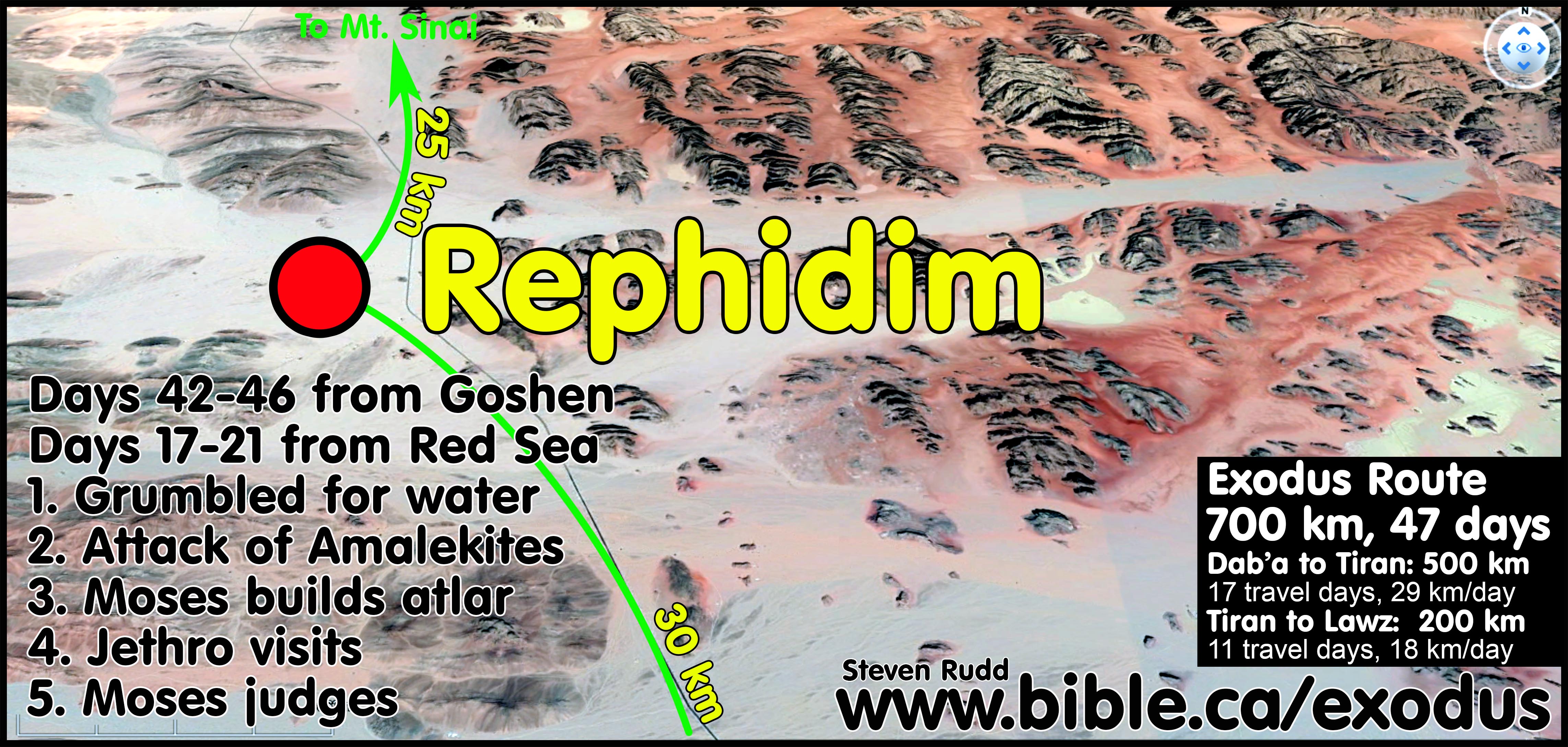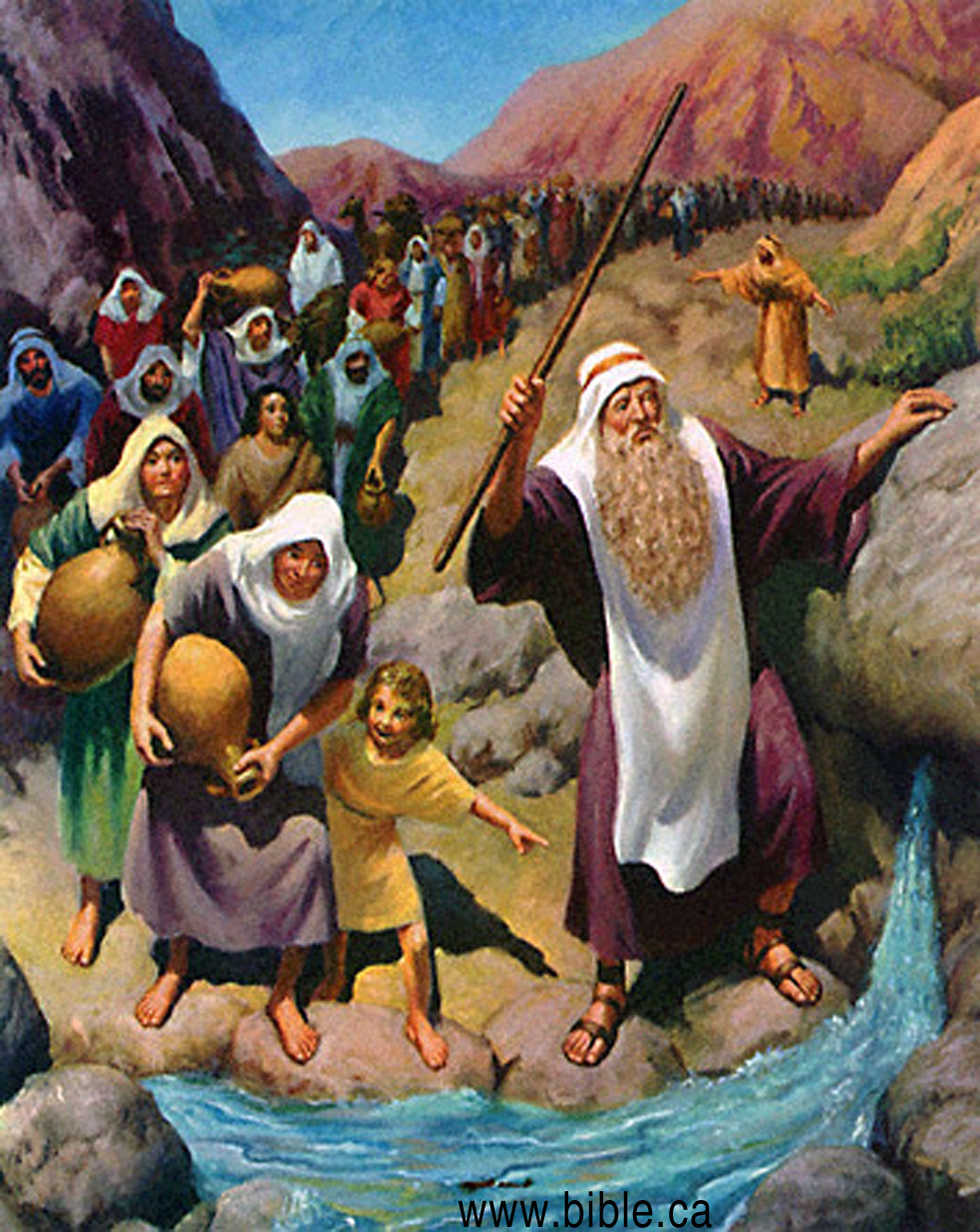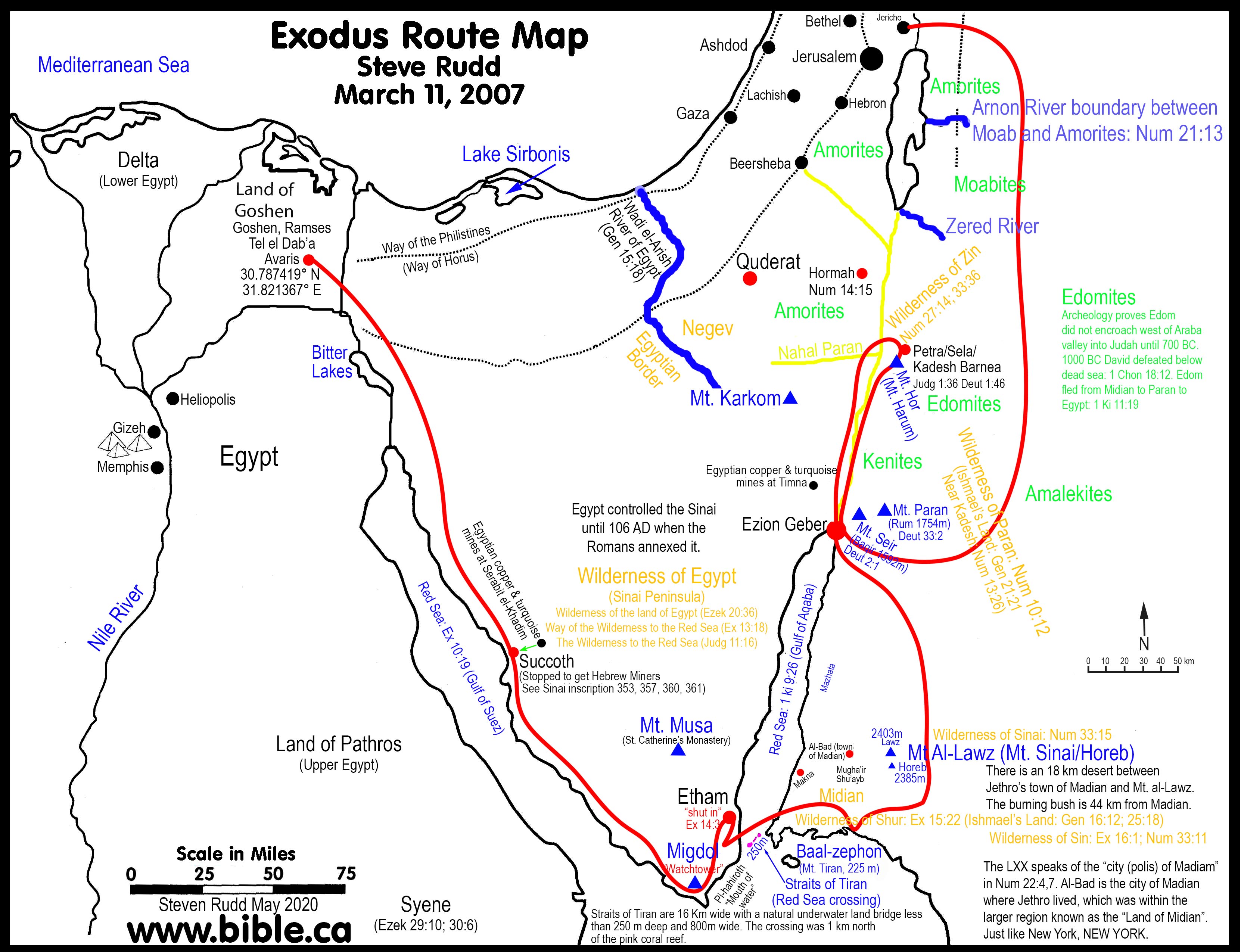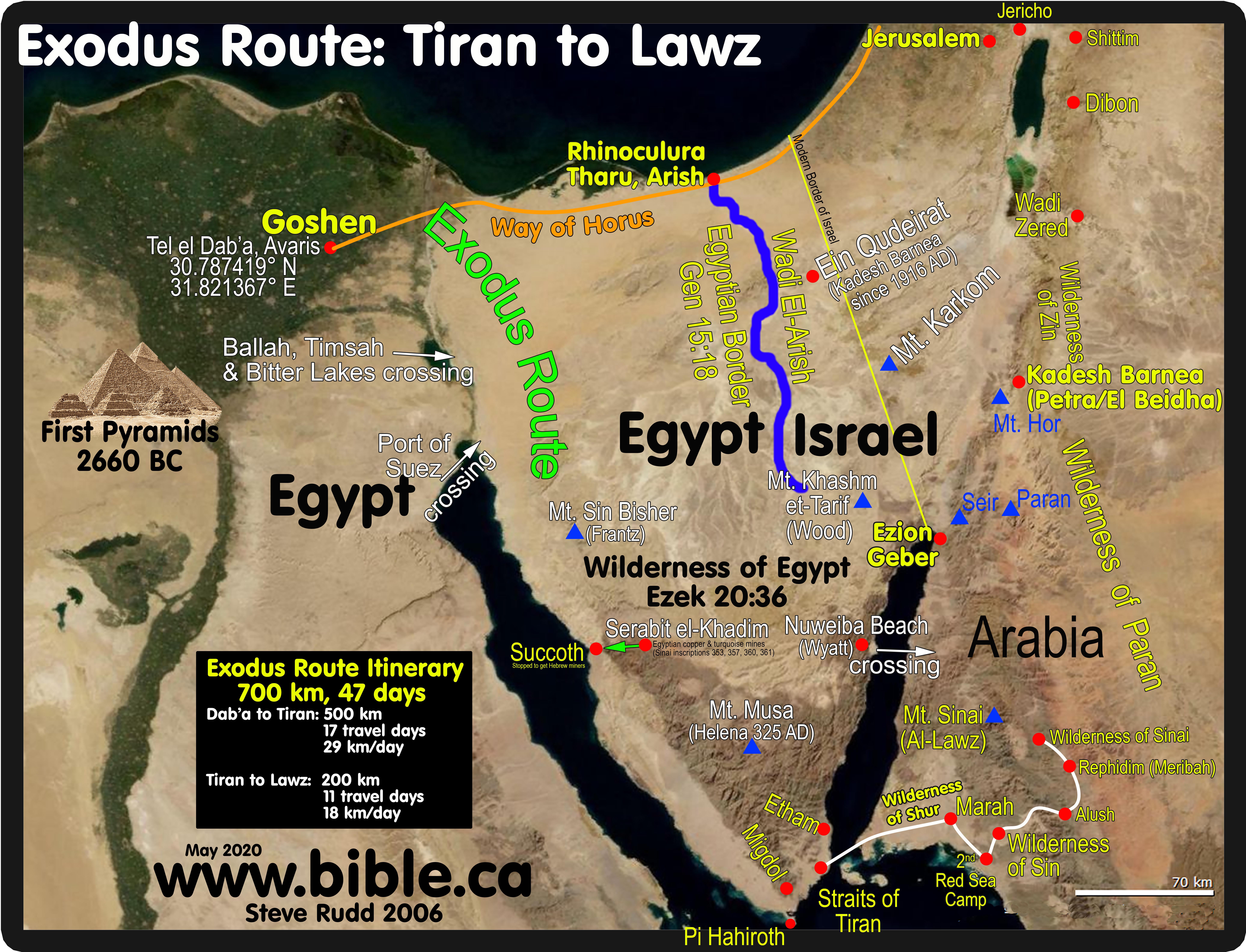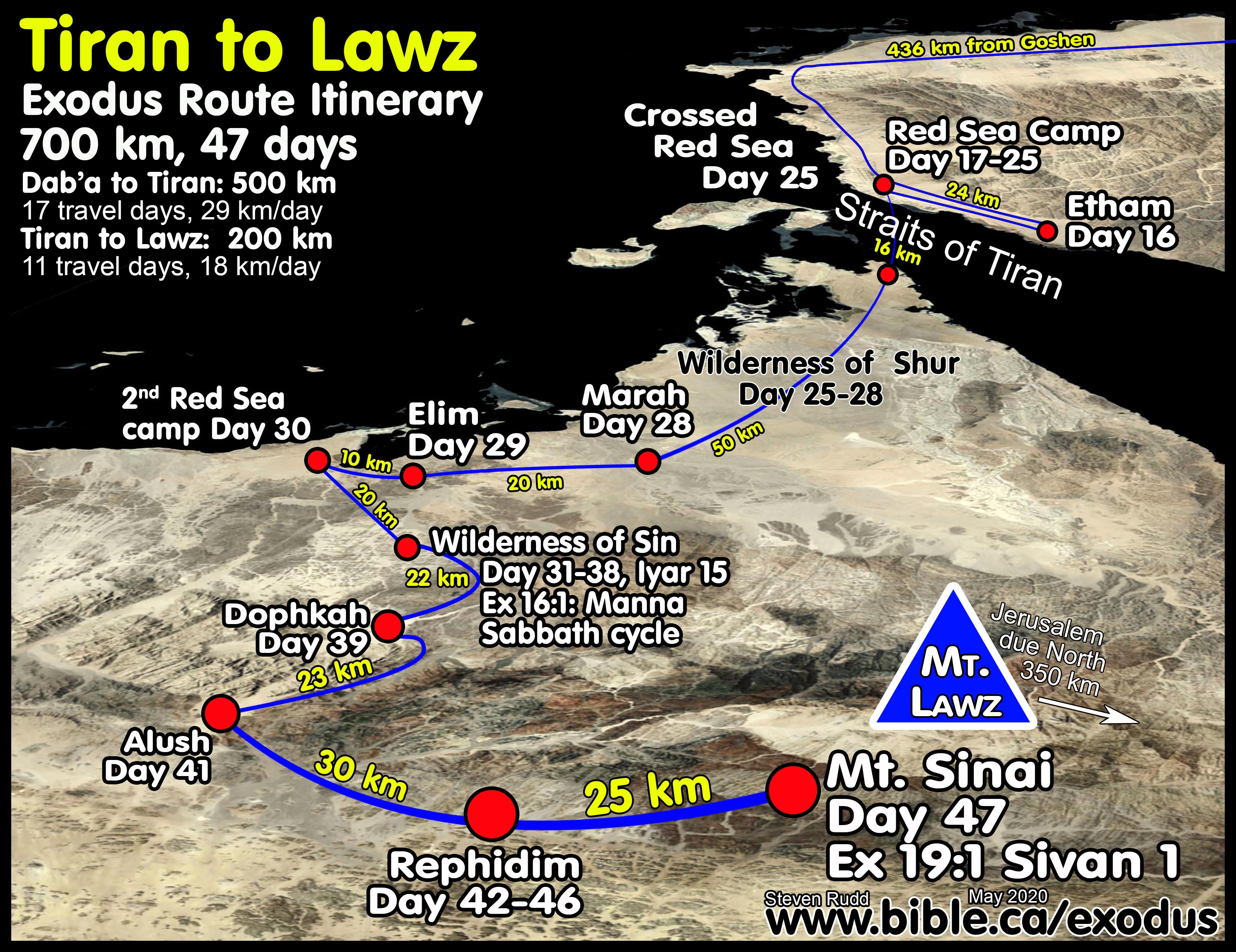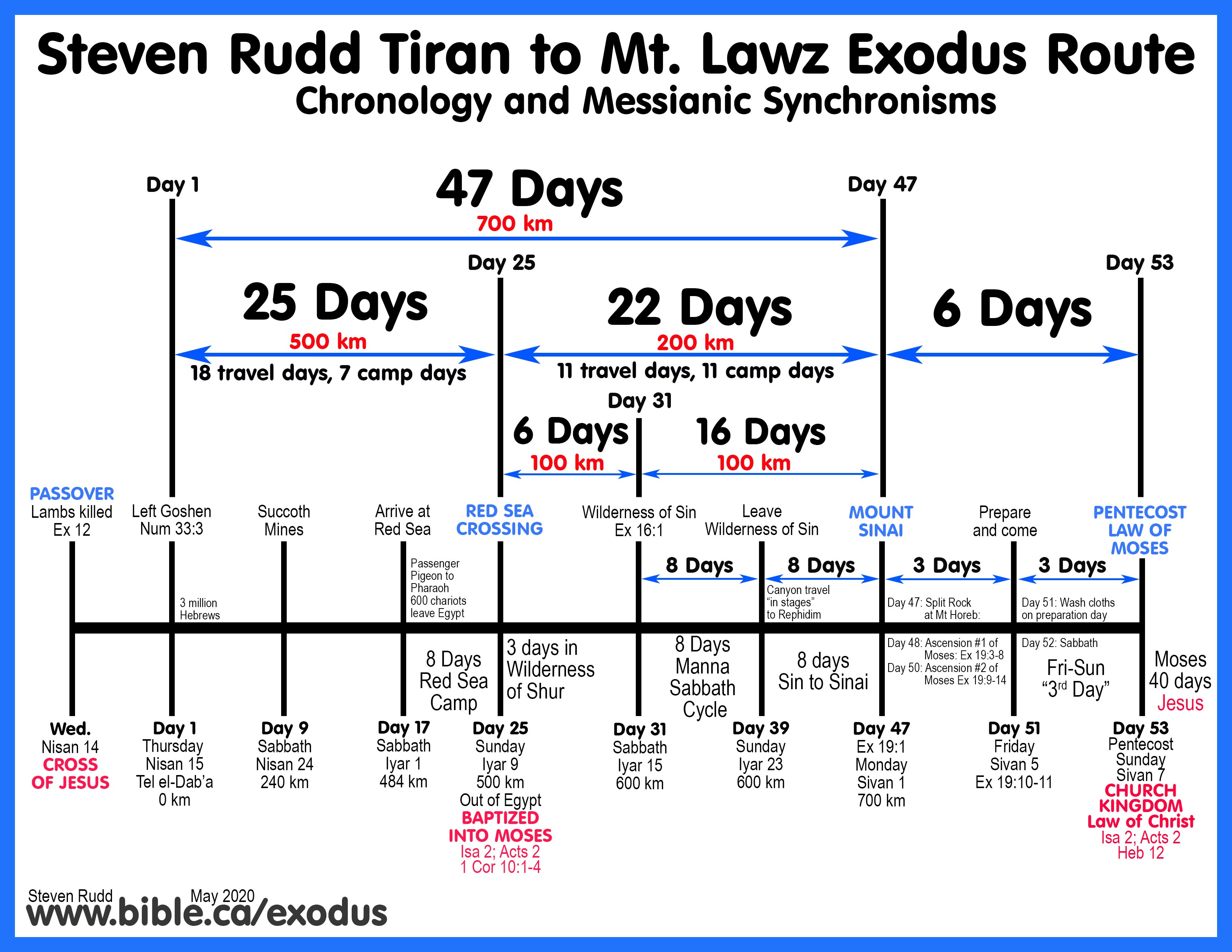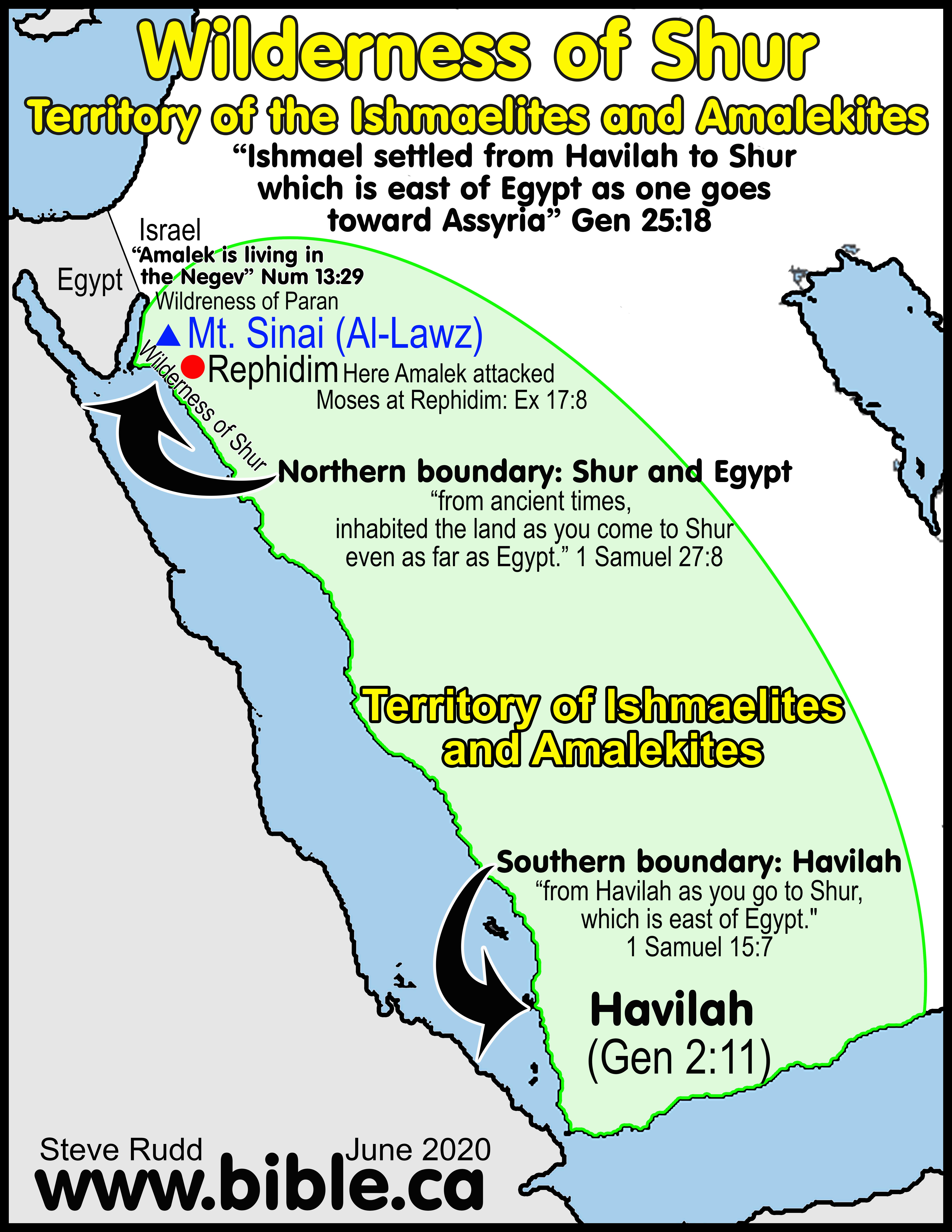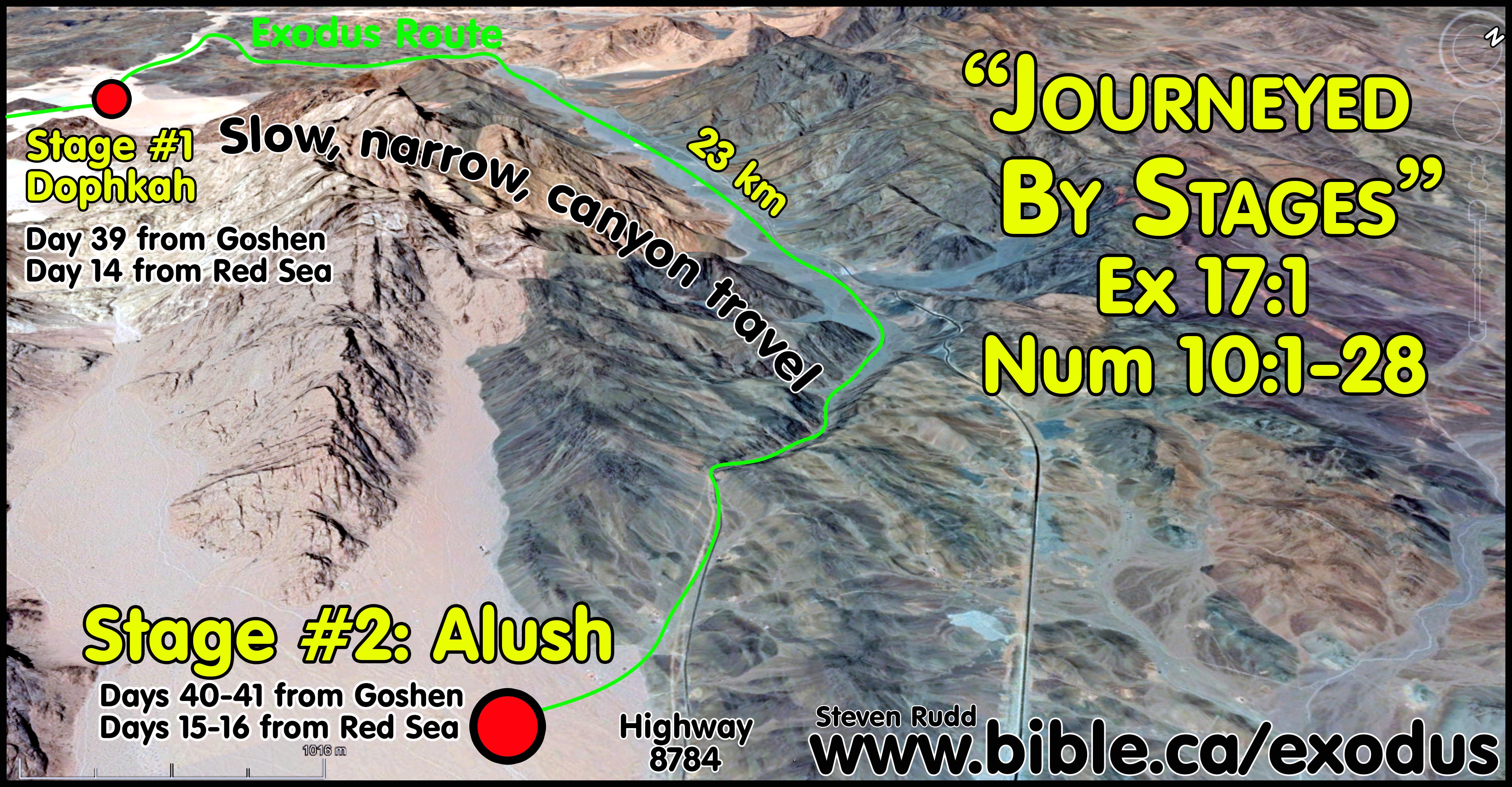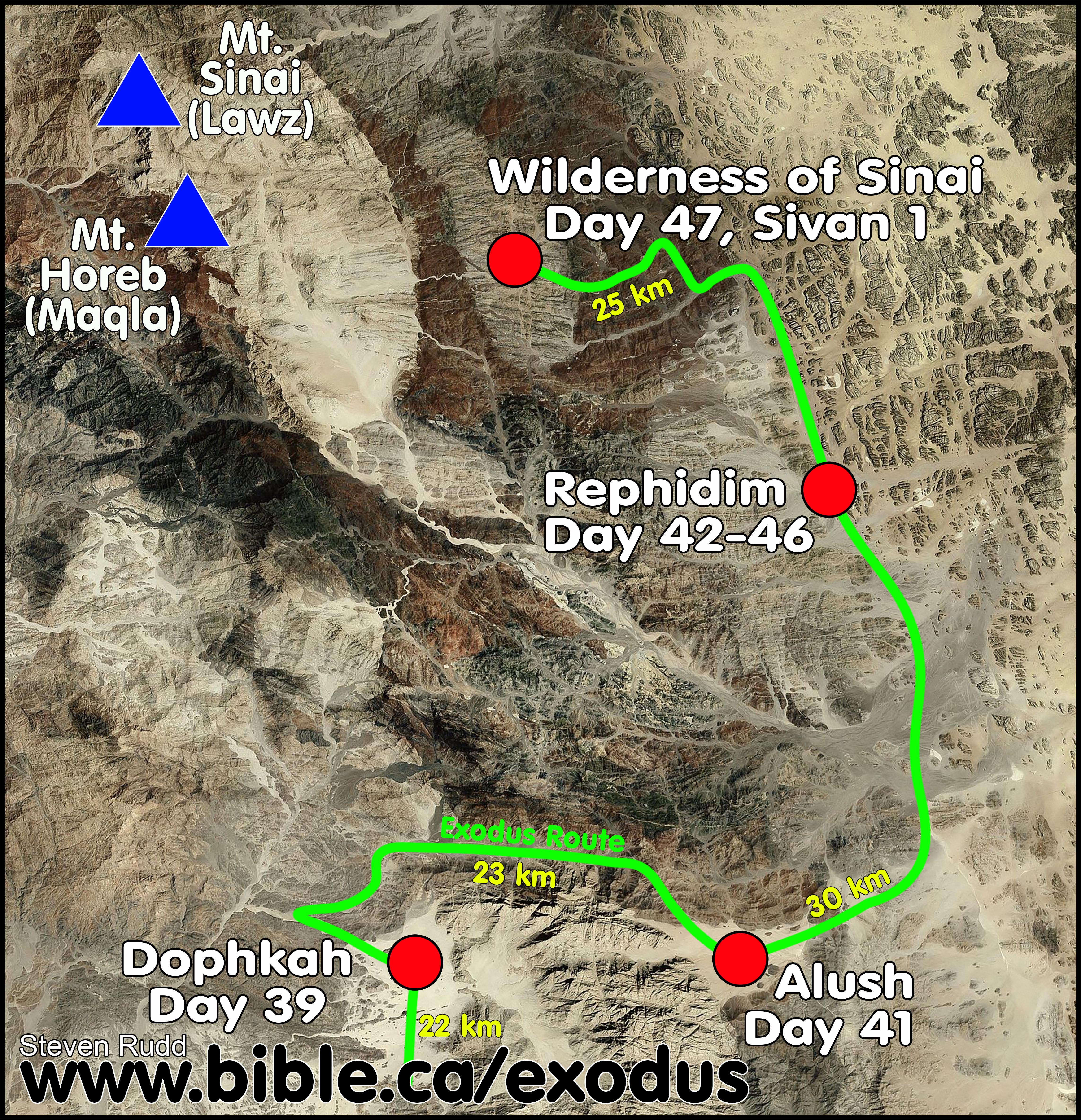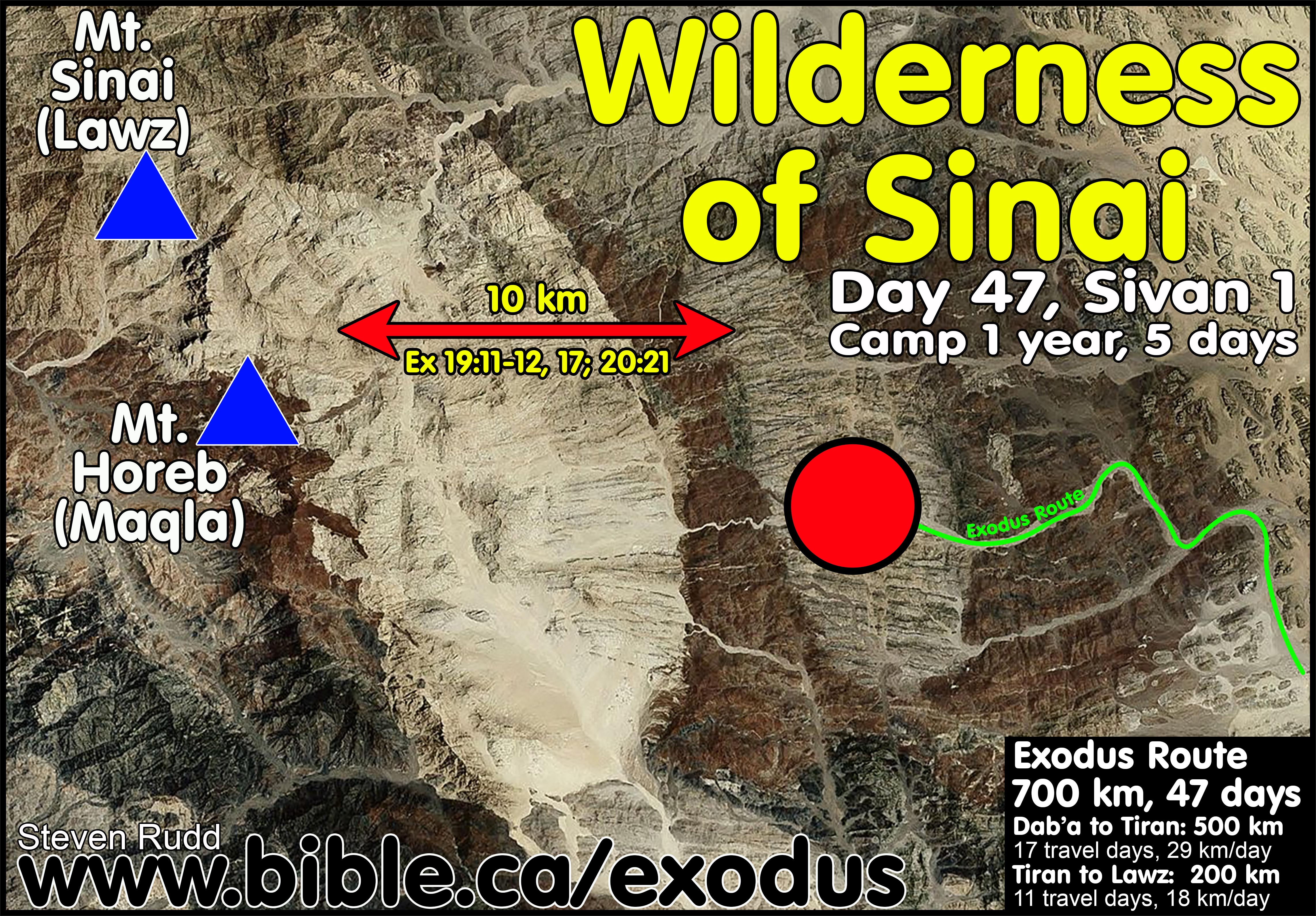The Exodus Route: Rephidim and the Split Rock of Moses for Water
Meribah, Amalek attacks, Jethro visits, Moses judges, 2nd Sabbath
The people grumbled at Rephidim, but Moses split the rock for water 5 days later at Mt. Horeb.
|
Israel complained at Rephidim, but Moses split the rock at Mt. Horeb 5 days later. Hebrews complained about water at Rephidim on day 42 from Goshen but Moses struck the rock for water 5 days later at Mt Horeb on day 47. The split rock at the foot of Mt. Sinai was 25 km Rephidim and served as the main water supply for the 3 million Hebrew during their 11-month, 5 day stay.
“He split the rocks in the wilderness and gave them abundant drink like the ocean depths. He brought forth streams also from the rock and caused waters to run down like rivers." (Psalm 78:15–16) |
|
Exodus locations:
|
Introduction:
1. The people grumbled at Rephidim, but Moses split the rock for water 5 days later at Mt. Horeb.
2. Rephidim is also called Massah (test) and Meribah (quarrel).
a. Rephidim is a large wilderness area of about 1000 sq. km..
b. There are two different places called "Meribah" in the exodus route: The first is here at Rephidim before they got to Sinai. The second is at Kadesh Barnea where Moses sinned in striking the rock and taking glory for himself.
3. Four key events at Rephidim:
a. Israel complains about water, but Moses strikes the rock 5 days later at Mt. Horeb.
b. Amalekites attack.
c. Moses builds and altar.
d. Jethro visits and watches Moses Judge the people and offers Moses advice.
4. Journey by stages between the wilderness of Sin to Rephidim
a. "Then all the congregation of the sons of Israel journeyed by stages from the wilderness of Sin, according to the command of the Lord, and camped at Rephidim, and there was no water for the people to drink." Exodus 17:1
b. This gives us important information about the type of terrain between Sin and Rephidim. There is only one reason they would travel by stages, and that is because they could not travel as one group because of the terrain.
c. In fact, from the time of leaving Goshen in Egypt, this is the first time they had to travel by stages. There is a wide coastal plain 300 km long down the east coast of the Gulf of Suez. After crossing the Red Sea at the Straits of Tiran, there is another wide open plain they could walk on until they get to the Wilderness of Sin. Between the wilderness of Sin and Rephidim are a number of narrow valleys about 200 meters wide. It is also more rugged and hilly. This would restrict the movement, so the Bible is right, they couldn't all go at once, but in stages between the two wildernesses plains. Amazing confirmation of the accuracy of the Bible story.
5. Early Christians created metaphoric messianic meanings for Rephidim:
a. “After this they come to “Raphidin [Rephidim].” Now Raphidin translates as “praise of judgment.” Praise most justly follows after toils. Yet of what reality is the praise for? Judgment, it says. So the soul that judges and discerns correctly becomes worthy of praise, that is to say, the soul that “judges all things spiritually and is itself judged by no one.”” (Origen, Homilies on Numbers 27.12.2, 400 AD)
A. Bible texts: Note: there are two different Meribah's in the Bible. One at Mt. Sinai and the second at Kadesh. Both were the main water supply for the 3 million Hebrews at Sinai and Kadesh.
1. Bible texts for Rephidim, Meribah, Massah: 1446 BC: Israel complained at Rephidim about no water but Moses struck the rock a few days later at the foot of Mt. Horeb (Mt. Maqla) as the major water supply for Israel for the 11 months 4 days they stayed at Mt. Sinai.
- "Then all the congregation of the sons of Israel journeyed by stages from the wilderness of Sin, according to the command of the Lord, and camped at Rephidim, and there was no water for the people to drink." Exodus 17:1
- "He named the place Massah and Meribah because of the quarrel of the sons of Israel, and because they tested the Lord, saying, "Is the Lord among us, or not?" Then Amalek came and fought against Israel at Rephidim." Exodus 17:7-8
- "When they set out from Rephidim, they came to the wilderness of Sinai and camped in the wilderness; and there Israel camped in front of the mountain." Exodus 19:2
- "They journeyed from Alush and camped at Rephidim; now it was there that the people had no water to drink. They journeyed from Rephidim and camped in the wilderness of Sinai." Numbers 33:15
- "Remember what Amalek did to you along the way when you came out from Egypt, how he met you along the way and attacked among you all the stragglers at your rear when you were faint and weary; and he did not fear God. "Therefore it shall come about when the Lord your God has given you rest from all your surrounding enemies, in the land which the Lord your God gives you as an inheritance to possess, you shall blot out the memory of Amalek from under heaven; you must not forget." Deuteronomy 25:17-19
- "He named the place Massah and Meribah because of the quarrel of the sons of Israel, and because they tested the Lord, saying, "Is the Lord among us, or not?"" Exodus 17:7
- ""You shall not put the Lord your God to the test, as you tested Him at Massah." Deuteronomy 6:16
- ""Again at Taberah and at Massah and at Kibroth-hattaavah you provoked the Lord to wrath." Deuteronomy 9:22
- "Of Levi he said, "Let Your Thummim and Your Urim belong to Your godly man, Whom You proved at Massah, With whom You contended at the waters of Meribah;" Deuteronomy 33:8
- "Do not harden your hearts, as at Meribah, As in the day of Massah in the wilderness," Psalm 95:8
- ""You called in trouble and I rescued you; I answered you in the hiding place of thunder; I proved you at the waters of Meribah.Selah." Psalm 81:7
- "Do not harden your hearts, as at Meribah, As in the day of Massah in the wilderness," Psalm 95:8
2. Bible texts for the second Meribah at Kadesh Barnea: 1444-1406 BC
a. "for in the wilderness of Zin, during the strife of the congregation, you rebelled against My command to treat Me as holy before their eyes at the water." (These are the waters of Meribah of Kadesh in the wilderness of Zin.)" Numbers 27:14
b. "because you broke faith with Me in the midst of the sons of Israel at the waters of Meribah-kadesh, in the wilderness of Zin, because you did not treat Me as holy in the midst of the sons of Israel." Deuteronomy 32:51
c. "Those were the waters of Meribah, because the sons of Israel contended with the Lord, and He proved Himself holy among them." Numbers 20:13
d. "Aaron will be gathered to his people; for he shall not enter the land which I have given to the sons of Israel, because you rebelled against My command at the waters of Meribah." Numbers 20:24
e. "Of Levi he said, "Let Your Thummim and Your Urim belong to Your godly man, Whom You proved at Massah, With whom You contended at the waters of Meribah;" Deuteronomy 33:8
f. "They also provoked Him to wrath at the waters of Meribah, So that it went hard with Moses on their account;" Psalm 106:32
B. Chronological sequence of events at Rephidim:
1. Sunday, day 39 from Goshen, day 14 from the Red Sea:
a. All 3 million Hebrews leave the Wilderness of Sin and arrive at Dophkah to camp the night.
b. Once they arrived at Dophkah, they shuttled through the mountain canyons by small group “stages” between Dophkah and Alush over 2-3 days to reach Rephidim.
c. Each small group would take about 6 hours to travel the 23 km between Dophkah and Alush.
2. Monday, day 40 from Goshen, day 15 from the Red Sea:
a. Stages of small groups of Hebrews depart Dophkah and begin the 23 km canyon travel and camp at Alush overnight.
b. The Hebrews who stayed behind at Dophkah, camp a second night at Dophkah.
3. First camp day at Rephidim: Tuesday, day 41 from Goshen, day 16 from the Red Sea:
a. The last of the Hebrews leave Dophkah and camp at Alush.
b. The first Hebrews travel 30 km and arrive at Rephidim at the head of a long precession travelling in small group stages between Dophkah and Alush.
c. Rephidim was the last stop before reaching Mt. Sinai and must therefore be one days journey away.
d. Moses arrives at Rephidim with the first “stage group” of Hebrews as other small groups journey behind.
4. Second camp day at Rephidim: Wednesday, day 42 from Goshen, day 17 from the Red Sea:
a. The last of the Hebrews leave Alush and journey 30 km to reach Rephidim.
b. complain to Moses about having no water: Ex 17:1-7.
c. The Hebrews at Rephidim complain that there is no water: Ex 17:1-7.
d. God tells Moses that when he later gets to Horeb (i.e. Mt. Sinai: Ex 17:6) there he will strike the rock to split it so water comes out for the 3 million Hebrews during their 11 month stay camped at Mt. Sinai.
e. Rephidim is not the location of the “split rock” it is where Israel complained about no water.
f. The Amalekites attacks Israel at Rephidim before the final group of 3 million Hebrews had arrived from Alush to Rephidim: Ex 17:8.
g. After the entire group of 3 million Hebrews arrive, Moses readies the Hebrew army to attack the Amalekites the next morning.
5. Third camp day at Rephidim: Thursday, day 43 from Goshen, day 18 from the Red Sea:
a. All 3 million Hebrews are now camped at Rephidim.
b. All day long, Israel fights and defeats the Amalekites as his hands are held up on the top of a hill: Ex 17:8-16.
c. Moses himself builds an altar and offers sacrifices: Ex 17:15. This altar was likely a few field stones or a mound of dirt. This altar would be the same appearance as what Aaron himself build for the golden calf at Mt. Sinai. These altars were simple, small and easily constructed by an 80-year-old man like Moses or 83-year-old Aaron.
d. Jethro arrives from Midian (Al Bad) and enters Moses’ tent. Jethro offers sacrifices and the heads of Israel eat a meal likely in part to celebrate the defeat of the Amalekites (Ex 18:1-12).
6. Fourth camp day at Rephidim: Friday, day 44 from Goshen, day 19 from the Red Sea:
a. Moses takes a rest day after the defeat of Amalek.
b. Moses judges the people from morning to night of their civil disputes: Ex 18:13.
c. Jethro watches Moses judge Israel all day long at Rephidim: Ex 18:13.
7. Fifth camp day at Rephidim: Second Sabbath, day 45 from Goshen, day 20 from the Red Sea:
a. This is the second sabbath of world history. The word Sabbath is not found in Genesis. Noah and Abraham, Isaac, Jacob and Joseph never kept the weekly sabbath.
b. Jethro takes advantage of the slow pace rest day to offer his advice to Moses about appointing 1000’s, 100’s and 10’s to help him judge the people: Ex 18:17.
8. Sunday, day 46 from Goshen, day 21 from the Red Sea:
a. Sunday morning, Moses implements the advice of Jethro and appoints men over 1000’s, 100’s and 10’s to judge the people.
b. Right from the beginning, Moses commanded fathers to teach their children how to read and right. Here at Rephidim, even before reaching Mt. Sinai, Moses appoints scribes to read and write the law. “Moses, in fact, took care to appoint teachers of reading and writing for God’s people before they had any written record of God’s Law. The Septuagint Scripture calls these instructors grammatoeisagōgoí, which is Greek for ‘bringers-in of letters,’ because they brought them, in a sense, into their students’ minds, or perhaps introduced their students to them.” (Augustine, City of God 18.39, 400 AD)
c. Jethro leaves Rephidim and returns to Midian (Ex 18:27).
d. In the afternoon, Moses departs and travels 25 km to the final camp at Mt. Sinai.
e. Moses arrives Sunday evening after sunset Sivan 1, day 47 (Ex 19:1). Hebrew days started at sunset.
9. Sivan 1, Monday, day 47 from Goshen, day 22 from the Red Sea, day 1 at Mt. Sinai: Ex 19:1
a. The 47-day journey from Goshen to Mt. Sinai is complete: Ex 19:1.
b. Monday morning day 47 from Goshen, Moses strikes the rock which will serve as the main water supply for 3 million Hebrews during their 11-month, 5 day stay: Ex 17:6. The people complained about the lack of water at Rephidim then five days later Moses strikes the rock at Mt. Horeb. Scripture says Moses was to strike the rock at Mt. Horeb, not at Rephidim.
10. Tuesday, day 48 from Goshen, day 23 from the Red Sea, Day 2 at Mt. Sinai:
a. Moses makes his 1st ascension up Mt. Sinai and comes back with an oath for the people (Ex 19:3-8).
C. Timing and distances:
1. Israel spent five overnight camp days at Rephidim: Days 41-45 from leaving Goshen, days 16-20 from the Red Sea crossing.
2. Rephidim is an important in determining the exodus route. It is only one stop next to the wilderness of Sinai. This means that Rephidim and the Wilderness of Sinai must be on the same (east) side of Mt. Sinai, or in close proximity.
![]() Travel
times, distances, days of the week
Travel
times, distances, days of the week
D. Calendar of events from Goshen to Sinai: Days 1-47
|
Sun |
Mon |
Tue |
Wed |
Thurs |
Fri |
Sat |
|
- |
- |
- |
Nisan 14: Passover lambs killed before sunset and eaten on Nisan 15 Wed evening. |
Day 1 Nisan 15: Departed in Daylight Num 33:3 |
2 |
3 Start counting 7 Sabbaths for Pentecost |
|
4 |
5 |
6 |
7 |
8 |
9 Succoth Overnight camp |
10 day 8 of Pentecost Nisan 24 |
|
11 |
12 |
13 |
14 |
15 Migdol |
16 Etham: Nisan 30 |
17 Iyar 1 |
|
18 camped at Red Sea |
19 Iyar 3 at Red Sea |
20 camped at Red Sea |
21 camped at Red Sea |
22 camped at Red Sea |
23 camped at Red Sea |
24 camped at Red Sea |
|
Iyar 9, saved and Shadow of First Fruits Lev 23:10-12 |
Day 1 after crossing |
28 Marah Day 3 after crossing |
29 Elim |
30 Iyar 14 Day 5 from Red Sea Crossing |
31 Iyar 15 Wilderness of Sin. Ex 16:1. Day 6 from Red Sea Crossing |
|
|
32 camped at Sin, 1st Manna |
33 camped at Sin |
34 camped at Sin |
35 camped at Sin |
36 camped at Sin |
37 camped at Sin. Day 12 from Crossing |
38 camped at Sin. 1st Sabbath |
|
39 Iyar23 Day 14 Leave wilderness of Sin for Dophkah |
40 Dophkah, Alush (small stage groups) Day 15 from Red Sea Crossing |
41 Alush, Rephidim (small stage groups) Day 16 from Red Sea Crossing |
Israel grumbles for water: Ex 17:6 Amalek attacks |
Moses hands held up to win war. Moses’ altar: Ex 17:15. Jethro arrives, eats meal Ex 18:12 |
Moses Judges the people all day: Ex 18:13 |
45 Iyar 29 Rephidim 2nd Sabbath. Jethro’s Advice: Ex 18:17 |
|
46 Iyar 30 Moses implements Jethro’s advice and leaves: Ex 18:27. Israel leaves for Wild. of Sinai |
47 Sivan 1 Wilderness of Sinai: Ex 19:1 Split rock for water at Horeb: Ex 17:6. Day 22 from crossing |
Day 48 Sivan 2 1st ascension oath for people |
Day 49 |
Day 50 Sivan 4 2nd ascension be ready on the third day: Ex 19:7-14 |
51 Sivan 5 “preparation day” to wash clothes |
52 Sivan 6 Day 49 of Pentecost, 7th Sabbath. Seder Olam 5.31 |
|
53 Pentecost Sivan 7 Moses hears 10 Comm. and laws |
54 Sivan 8 |
55 4th ascension Moses ascends with Aaron. laws repeated Ex 20-23 |
56 |
57 5th ascension Moses, Aaron, Nadab, Abihu, 70 elders. |
58 |
59 |
|
Sun |
Mon |
Tue |
Wed |
Thurs |
Fri |
Sat |
E. The grumbling for water and the split rock: Exodus 17:1-7
"Then all the congregation of the sons of Israel journeyed by stages from the wilderness of Sin, according to the command of the Lord, and camped at Rephidim, and there was no water for the people to drink. Therefore the people quarreled with Moses and said, "Give us water that we may drink." And Moses said to them, "Why do you quarrel with me? Why do you test the Lord?" But the people thirsted there for water; and they grumbled against Moses and said, "Why, now, have you brought us up from Egypt, to kill us and our children and our livestock with thirst?" So Moses cried out to the Lord, saying, "What shall I do to this people? A little more and they will stone me." Then the Lord said to Moses, "Pass before the people and take with you some of the elders of Israel; and take in your hand your staff with which you struck the Nile, and go. "Behold, I will stand before you there on the rock at Horeb; and you shall strike the rock, and water will come out of it, that the people may drink." And Moses did so in the sight of the elders of Israel. He named the place Massah and Meribah because of the quarrel of the sons of Israel, and because they tested the Lord, saying, "Is the Lord among us, or not?" Exodus 17:1-7
1. The people grumbled at Rephidim, but Moses split the rock for water 5 days later at Mt. Horeb: Exodus 17:1-7
a. COMPLAIN: Israel complained about water at Rephidim on day 42 from Goshen, day 17 from the Red Sea.
b. STRIKE: Moses splits the rock at Horeb on day Sivan 1, day 47 from Goshen, day 22 from the Red Sea
c. WASH: After Moses’ 2nd ascension, he tells the people to wash their clothes on Sivan 4, day 50 from Goshen, day 25 from the Red Sea: Ex 19:7-14, and be ready in three days when God would set Mt. Sinai on fire on Pentecost (Day 53).
2. In Ex 17:1-7 the people “grumbled” for water and “tested” God. Therefore, the two other names of this location are:
a. Massah (test)
b. Meribah (quarrel).
3. There are two different Meribah's in the Bible:
a. The first Meribah is at Rephidim, one stop from Mt. Sinai.
b. The second Meribah is at Kadesh Barnea.
4. Moses splits the rock at Horeb and Kadesh Barnea:
a. "He split the rocks in the wilderness and gave them abundant drink like the ocean depths. He brought forth streams also from the rock and caused waters to run down like rivers." (Psalm 78:15–16)
b. This became the main water supply for the Hebrews at Mt. Sinai for 11 months and Kadesh Barnea for 38 years.
5. There are two different slit rocks in the Bible that served at the main water supply for the 3 million Hebrews:
a. The first split rock for water was at the foot of Mt. Horeb (Mt. Maqla), beside Mt. Sinai (Mt. Lawz) and we have no idea today where this rock is located.
b.
The second split rock for water is at Kadesh Barnea, located at modern
Petra. The Wadi Musa (River of Moses) is the Siq at Petra and was the main flow
of water over 1 km in length. The Ain Musa (Spring of Moses) at Petra was the
slit rock which served at the water source and was mentioned by both Eusebius
and Jerome.
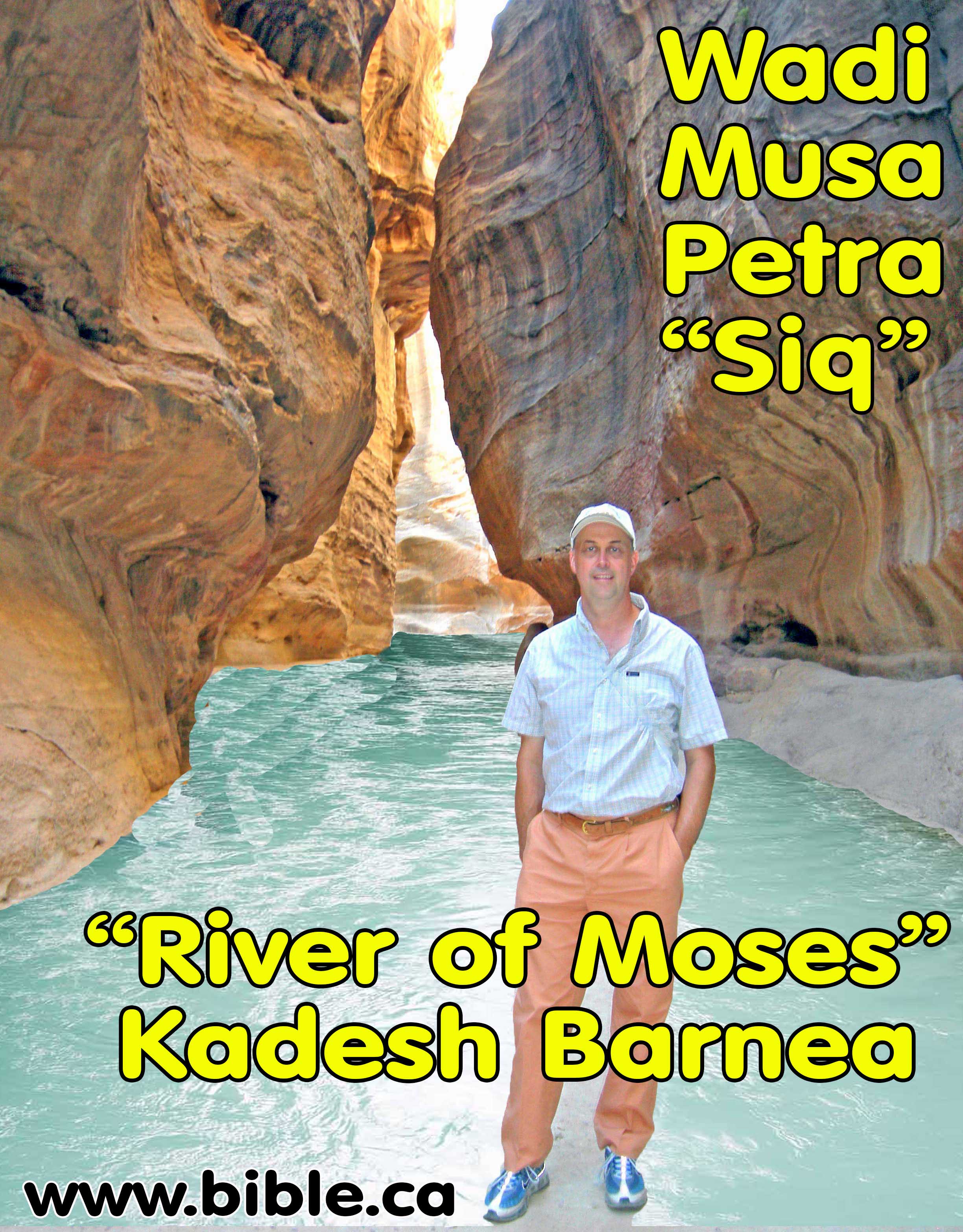
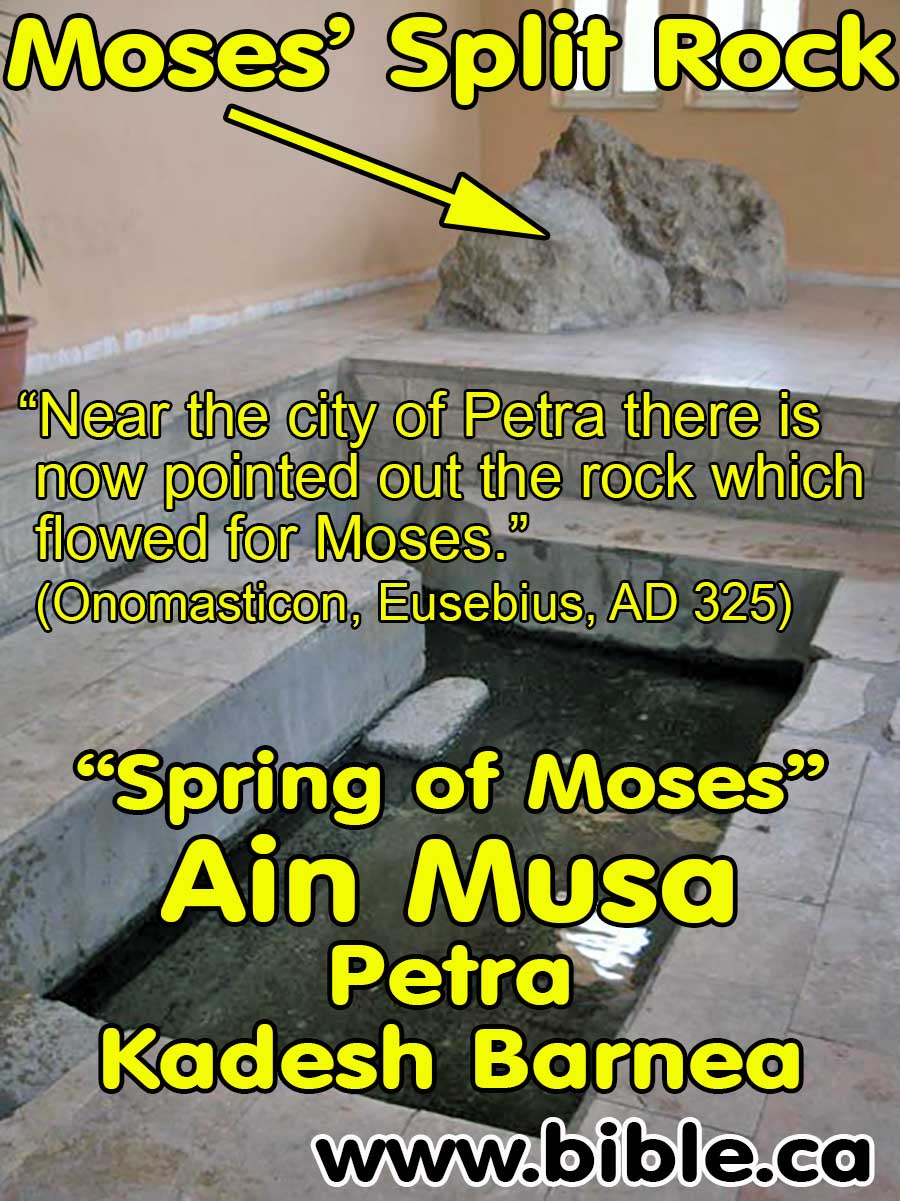
6. Ancient Literary sources that Kadesh Barnea was at Petra:
a. AD 70 Josephus:
"Then it was that Miriam, the sister of Moses, came to her end, having
completed her fortieth year since she left Egypt, on the first day of the lunar
month Xanthicus. They then made a public funeral for her, at a great
expense. She was buried upon a certain
mountain, which they call Sin; and when they
had mourned for her thirty days ... Now when this purification, which their
leader made upon the mourning for his sister, as it has been now described, was
over, he caused the army to remove and to
march through the wilderness and through Arabia;
and when he came to a place which the Arabians
esteem their metropolis, which was formerly called Arce, but has now the name
of Petra, at this place, which was encompassed with high mountains, Aaron went
up one of them in the sight of the whole
army, Moses having before told him that he was to die, for this place was over
against them." (Josephus, Antiquities 4.82-83)
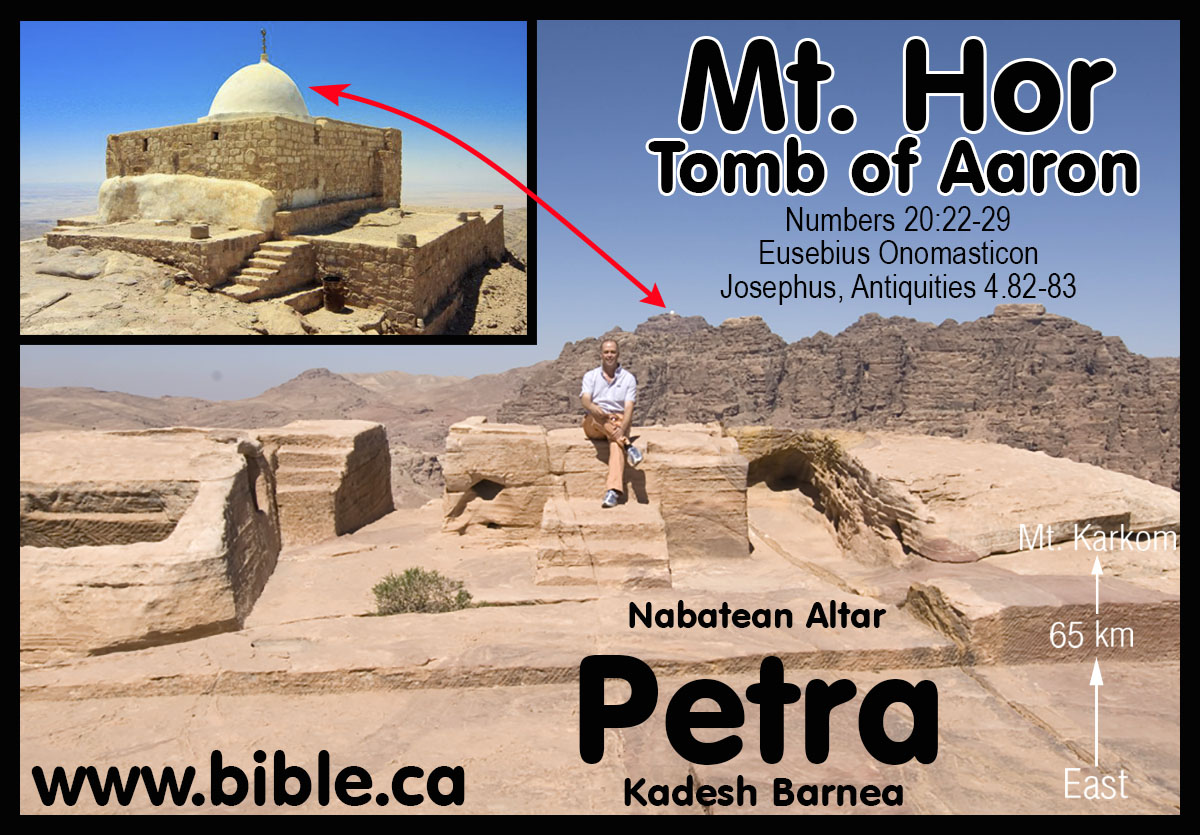
b. AD 325 Eusebius: "Beroth. "Of the sons of Jakeim (Iacim)." Place in the desert where Aaron died. It is pointed out (still today) ten miles from Petra on the summit of the mountain." (The Onomasticon, Eusebius, Beroth, 325 AD)
c. AD 325 Eusebius: "Kadesh Barnea (or Cades Barnea): "Kadea Barne. The desert which extends to (the city of) Petra a city of Arabia. There Mariam went up and died, and there the doubting Moses struck the rock to give water to the thirsty people. The tomb of Mariam herself is pointed out there even now." (The Onomasticon, Eusebius, Kadesh Barnea, 325 AD)
d. AD 325 Eusebius: "Mt Hor: ōr. Mountain on which Aaron died near the city of Petra. There is now pointed out the rock which flowed for Moses (which Moses struck and gave water to the people)." (The Onomasticon, Eusebius, Mt. Hor, 325 AD)
e. AD 400 Jerome: "Gen 14:7: And they returned and came to the fountain of judgement, that is, to Cades. Because Cades was so named later on, it is specified by way of anticipation; and it refers to a place near Petra, which is called 'The Fountain of Judgement', because God judged the people there" (Saint Jerome's Hebrew Questions on Genesis, translated by C. T. R. Hayward, p 46, Gen 14:7, 1995 AD)
7. Jesus "The Rock of Salvation" in the Bible:
a. The theological significance of God bringing water from the rock at Kadesh and Sinai cannot be overlooked.
b. The first reference to God being the "Rock" after Moses struck the rock, is: "The Rock! His work is perfect, For all His ways are just; A God of faithfulness and without injustice, Righteous and upright is He." Deuteronomy 32:4.
c. David adopted the “God my Rock” imagery: “I love You, O LORD, my strength.” The LORD is my rock and my fortress and my deliverer, My God, my rock, in whom I take refuge; My shield and the horn of my salvation, my stronghold. I call upon the LORD, who is worthy to be praised, And I am saved from my enemies." (Psalm 18:1-3)
d. The last reference is: "and all drank the same spiritual drink, for they were drinking from a spiritual rock which followed them; and the rock was Christ." 1 Corinthians 10:4
e. The imagery of Christ as "The Rock", as well as all the varied "rock" imagery throughout the Bible, has its origin in Moses at Sinai and Kadesh.
f. Moses striking the rock lays the foundation of a major Bible anti-type applied directly to Christ as the Rock that provides food and water for salvation, safety, security, and judgement.
g. Detailed study about the water Moses provided by miracle at Sinai and Kadesh.
8. Debunking and refuting Unicorn Internet Archaeologists
(UIA) who popularize Ron Wyatt’s ridiculous split rock which is on the wrong
side of the mountain. These UIAs include Ron Wyatt, Larry Williams, Bob
Cornuke, David Fasold, Howard Blum, Larry Williams, Lennart Möller, Jim
Caldwell, Penny Caldwell, Ryan Mauro, Andrew Jones, Joel Richardson. It takes
more than a camera and a wild imagination to do professional archeology.
WARNING: FAKE NEWS ALERT!!! DEBUNKED
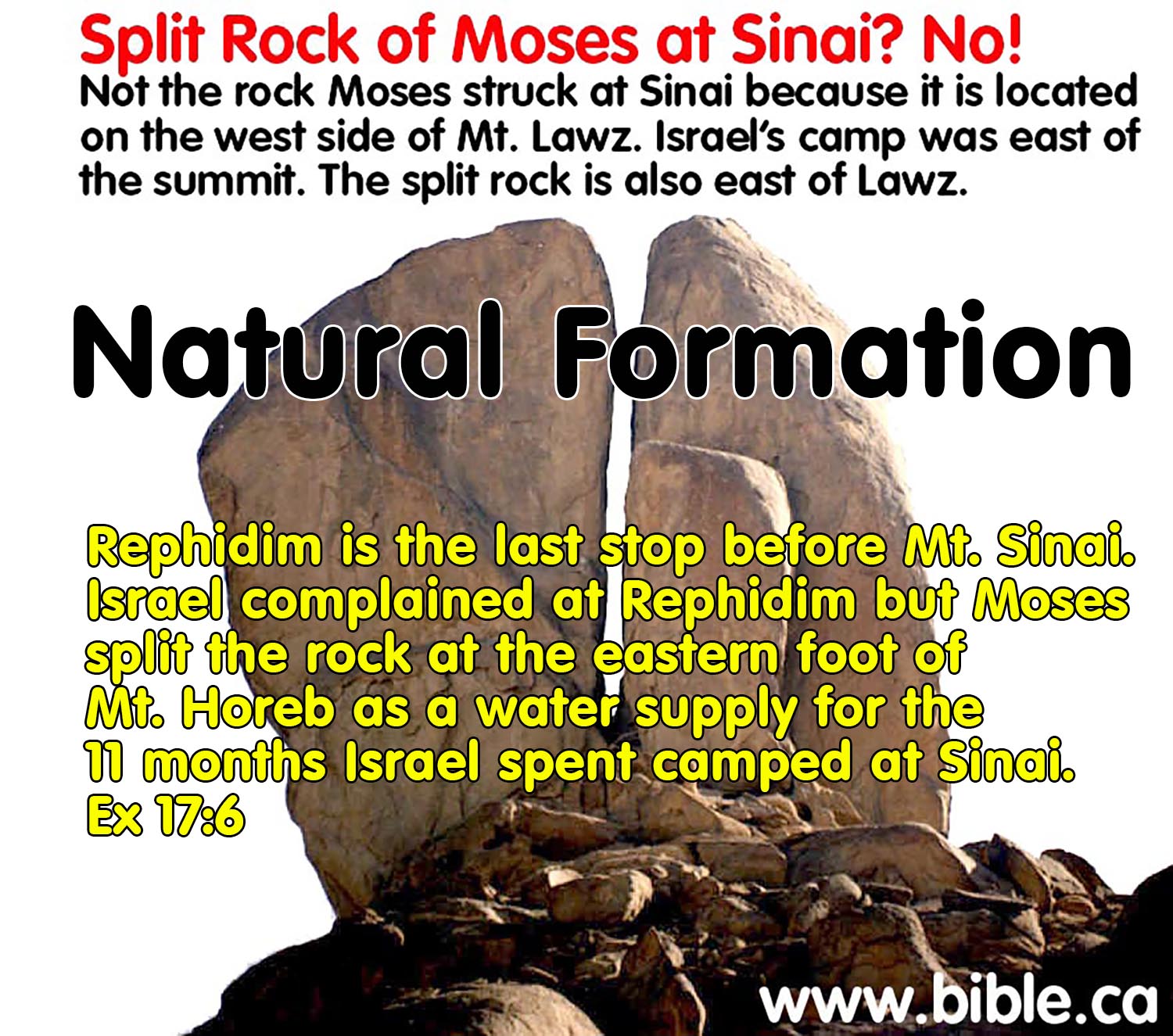
a. The Bible says Israel complained about water at Rephidim, but Moses split the rock is at Mt. Horeb, so anybody who puts the split rock at Rephidim gets an automatic FAIL.
b. These UIA all advocate the Nuweiba Red Sea crossing and wrongly place Rephidim on the west side of the mountain at gps 28°43'31.35"N 35°14'15.36"E (28.726000° 35.236000°), and correctly place the wilderness of Sinai on the east side. Rephidim is the last stop before reaching Mt. Sinai. Using the exodus route maps of these Unicorn Internet Archaeologists, it is 80 km through rugged canyons from their “split rock” and final camp at Mt. Sinai. Most of these UIAs never even think to produce topographical exodus route maps and the few who do lack detail and often track directly over high mountain summits. If you encounter one of these entertainers, equipped with a drone and a flashy internet video, say, “show me your exodus route map”. In the unlikely case they have produced one themselves, notice the lacking second Red Sea camp or any day counts and distances between stops.
c. Their 180 km northern route after crossing at Nuweiba is almost entirely canyon travel where the width is often between 100 - 300 meters wide in the valleys between hills. The Bible says the only canyon travel was between the Wilderness of Sin and Rephidim, yet all of their route is canyon travel.
d.
From Nuweiba to the “split
rock” is about 70 km through narrow canyons and there is no possible location
for the second Red Sea camp which is an automatic FAIL. With only one stop left before reaching Mt. Sinai, they
must travel another 110 km through narrow canyons from Rephidim to Mt Sinai.
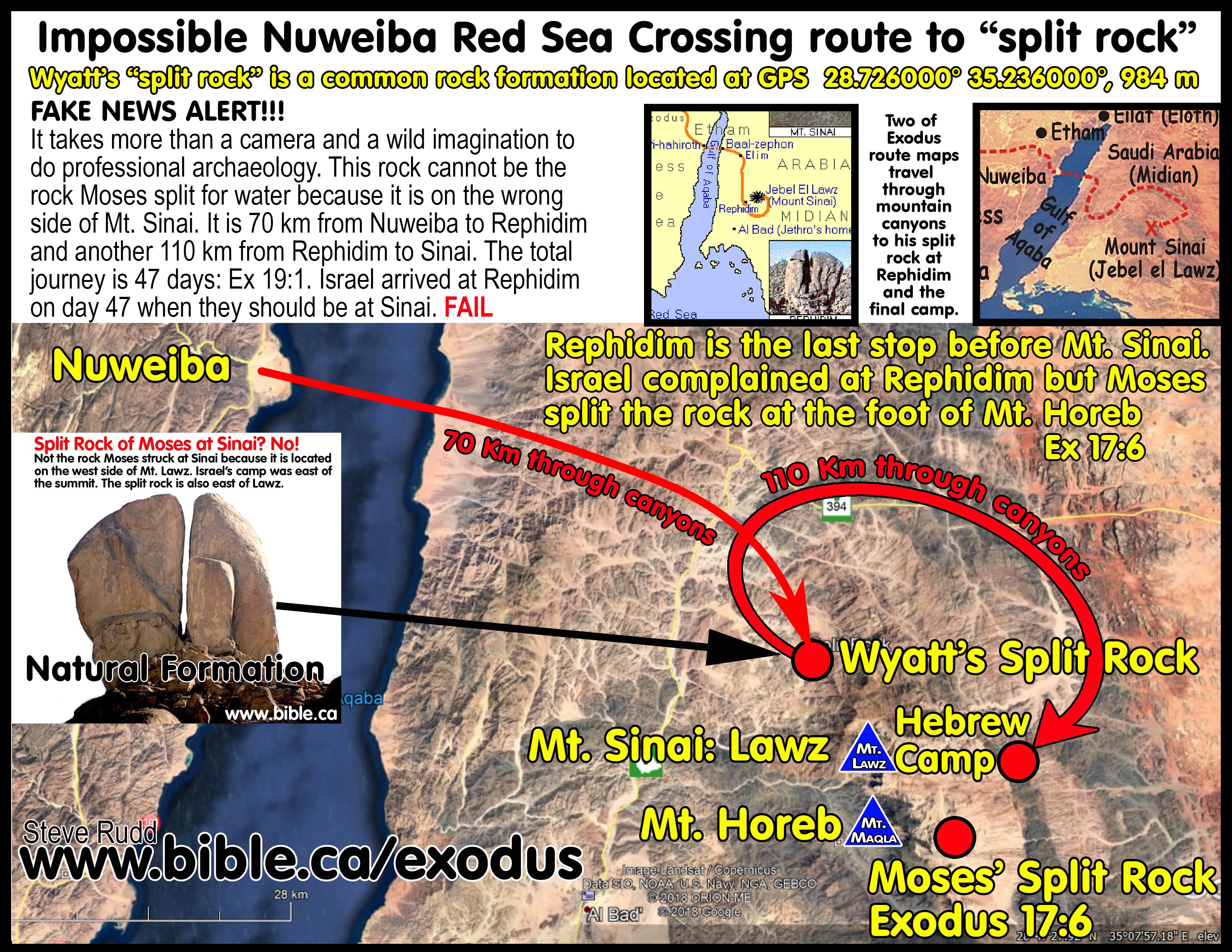
e.
Timing is a huge problem for
the Nuweiba crossing because there are only 22 days available to reach Mt.
Sinai. We know the entire journey from Goshen to Mt. Sinai took 47 days (Ex
19:1). They arrive at the Wilderness of Sin on day 31 from Goshen, day 6 from
Nuweiba, camp 8 days to learn the Manna/Sabbath cycle then leave on day 38 from
Goshen, day 14 from the Red Sea crossing. Now they only have 8 days left to
reach Mt. Sinai but they must travel farther away, in the opposite direction of
the final camp at Mt. Sinai to camp at Dophkah, Alush and finally Rephidim.
When they arrive at Rephidim, they now only have 5 days to reach Mt. Sinai. There
are at least 5 camp days at Rephidim to fight the Amalekites, host the visit of
Jethro where watches Moses Judge Israel and a second Sabbath day on day 45 from
Goshen. These Internet Unicorn Archaeologist then have Israel leaving Rephidim
on day 22, travelling 110 km through narrow and difficult canyons and reach Mt.
Sinai THE SAME DAY. The entire journey from Goshen to Mt. Sinai is 47 days (Ex
19:1) and they arrived at the Wilderness of Sin on day 31. These devastating
details never makes it into their fancy internet movies that appear so
convincing to the naive. FAIL.
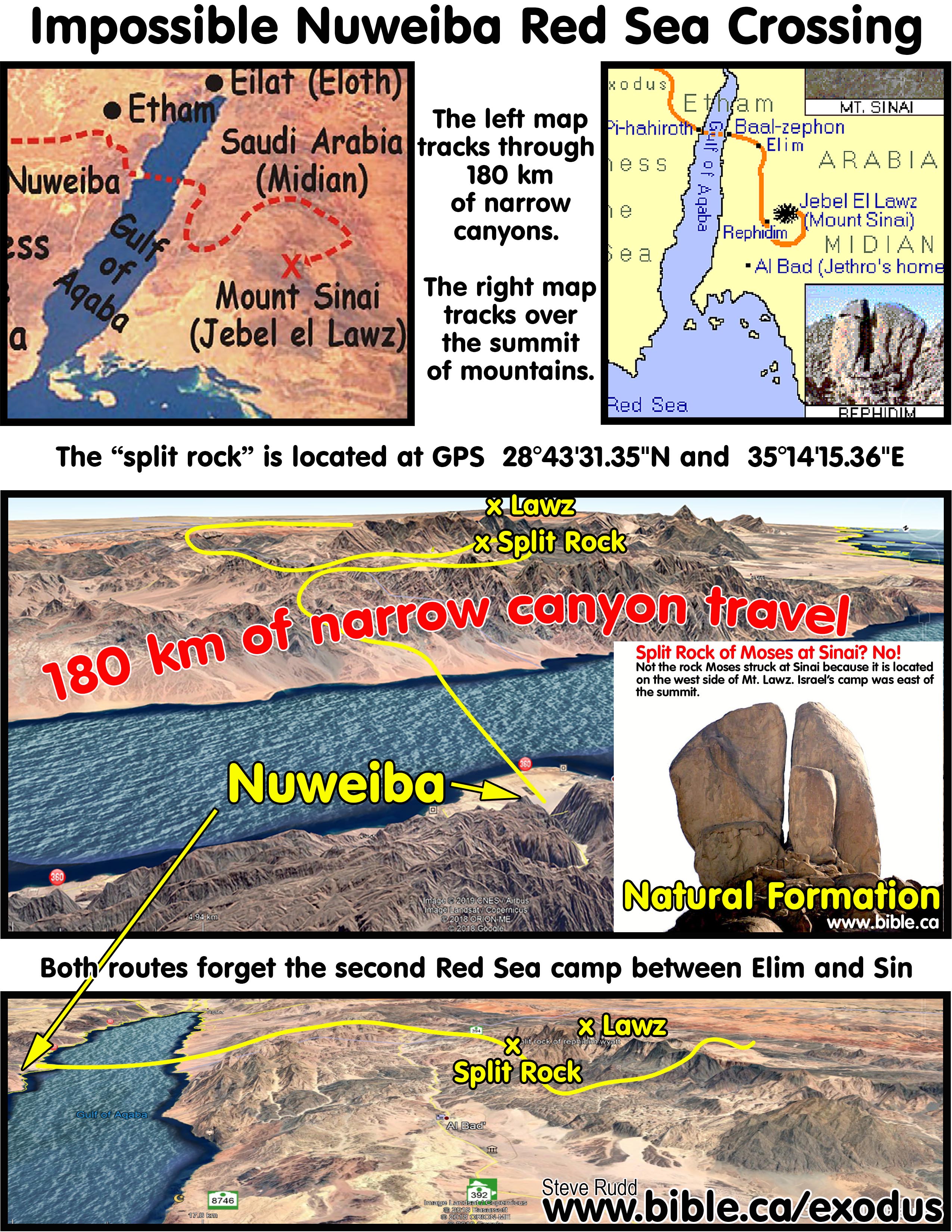
f. Rule #1: There is no known archaeological evidence of Moses in Saudi Arabia. Rule #2: Ignore everything these Unicorn Internet Archaeologists say about Bible archaeology: Ron Wyatt, Larry Williams, Bob Cornuke, David Fasold, Howard Blum, Larry Williams, Lennart Möller, Jim Caldwell, Penny Caldwell, Ryan Mauro, Andrew Jones, Joel Richardson. It takes more than a camera and a wild imagination to do professional archeology. Enough damage has been done to the cause of Christ by these money and fame seeking entertainers. TOTAL FAIL.
F. The ambush by Amalek: Ex 17:8-16
1. The Amalekites were a tribe had their origin within the Edomites, being descendants of Esau.
a. "Chief Korah, chief Gatam, chief Amalek. These are the chiefs descended from Eliphaz in the land of Edom." (Genesis 36:16)
b. They are often associated with Edom, but were a distinct nation from Edom: "King David also dedicated these to the Lord with the silver and the gold which he had carried away from all the nations: from Edom, Moab, the sons of Ammon, the Philistines, and from Amalek." (1 Chronicles 18:11)
c. Their traditional territory is transjordan between Babylon and the Arabian Gulf, which explains why they attacked Israel at Rephidim.
d. At the time of the exodus, the Amalekites also lived in the Negev just west of Petra: Numbers 13:29
e. At the time of David, the Amalekites lived in the Negev: "Then it happened when David and his men came to Ziklag on the third day, that the Amalekites had made a raid on the Negev and on Ziklag, and had overthrown Ziklag and burned it with fire;" (1 Samuel 30:1)
2. As Israel navigated the canyon travel between the Wilderness of Sin and Rephidim the Amalekites attacked.
a. This was a brilliant tactical move by Amalek because only a fraction of the 3 million Hebrews had arrived and there was a shortage of water.
b. Amalek attacked the last group of Hebrews traversing the canyons between Dophkah and Alush.
c. When the battle started the morning after the Amalekites attacked, all the 3 million Hebrews were camped together at Rephidim as a single unit.
d. The battle was centered at Rephidim.
e. Moses climbed up a hill that all Israel
could see him. We have no idea where this hill is located since there are
dozens of possible hills in the Rephidim area. Moses lifted up his hands and
Israel was winning the war. But he got tired and dropped them, which gave
Amalek the advantage. So, they held up Moses hands for him and Israel defeated
Amalek. Sometimes great leaders need help.
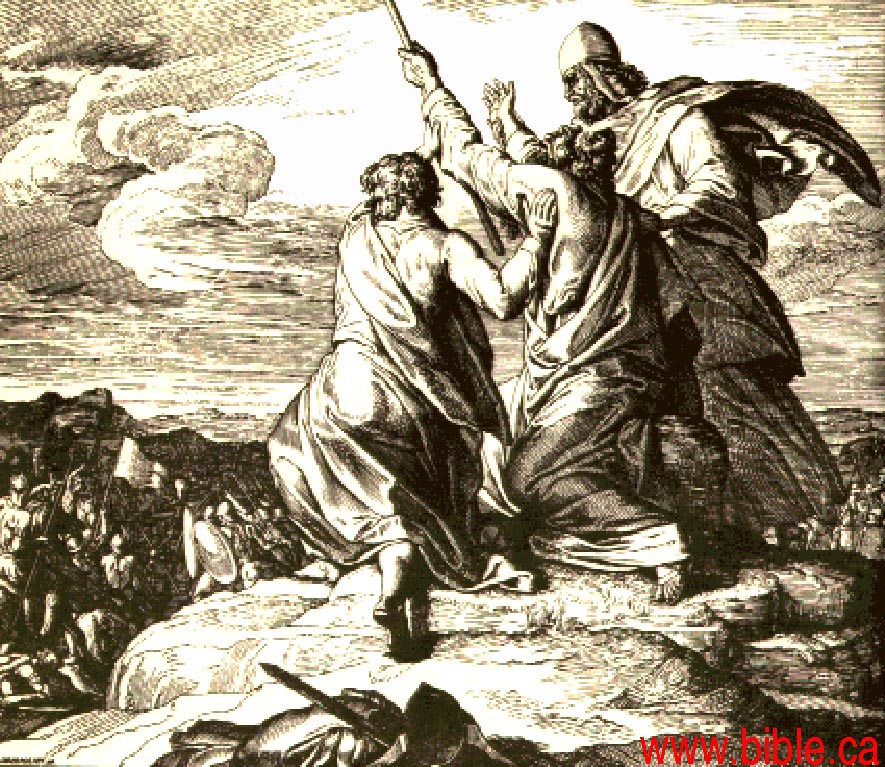
f. "Remember what Amalek did to you along the way when you came out from Egypt, how he met you along the way and attacked among you all the stragglers at your rear when you were faint and weary; and he did not fear God. "Therefore it shall come about when the Lord your God has given you rest from all your surrounding enemies, in the land which the Lord your God gives you as an inheritance to possess, you shall blot out the memory of Amalek from under heaven; you must not forget." Deuteronomy 25:17-19
G. Jethro visited Moses at Rephidim not Mt. Sinai:
1. Moses deliberately inserts the visit of Jethro BEFORE his arrival at Mt. Sinai on day 47 (Ex 19:1).
a. Against the visit of Jethro at Mt. Sinai: If the visit of Jethro, Moses judging Israel and Jethro’s advice occurred months after Israel departed Rephidim, the chronological insertion at this point is puzzling and odd.
b. Against the visit of Jethro at Rephidim: Jethro appears to visit Moses at the final camp at Mt. Sinai. The people came to Moses so he could explain the laws and statutes of God. “When they have a dispute, it comes to me, and I judge between a man and his neighbor and make known the statutes of God and His laws.” (Exodus 18:16) This indicates that Jethro visited after day 99 from Goshen, when Moses returned from being 40 days on the summit of Mt. Sinai during his 6th ascension: Ex 24:12-18. In this case, the “statues and laws” refer to specifics revealed AFTER Moses arrived at Mt. Sinai.
2. Argument #1 in favour of Jethro’s visit at Rephidim: The locative is lacking in the Hebrew (MT) but present in the Greek Septuagint (LXX) in Ex 18:5:
a. "Then Jethro, Moses’ father-in-law, came with his sons and his wife to Moses in the wilderness where he was camped, at [no Hebrew word I manuscript] the mount of God." (Exodus 18:5, MT)
b. "And Jethro, the father-in-law of Moses, and his sons and his wife went forth to Moses into the wilderness, where he had encamped near [epi, ἐπί] the mountain of God." (Exodus 18:5, LXX)
a. c. "Here, I will stand there before you, upon [epi, ἐπί] the rock at [epi, ἐν] Horeb, and you will smite the rock, and water will come out of it, and my people will drink.” And Moses did so in the presence of the children of Israel." (Exodus 17:6, LXX)
c. The Greek has two different words for being AT [epi, ἐν] a location as opposed to being NEAR [epi, ἐπί] it:
3. Argument #2 in favour of Jethro’s visit at Rephidim: God revealed statutes and laws at the Wilderness of Sin where Moses was the only one who instructed and judged:
a. “I may test them, whether or not they will walk in My instruction” Ex 16:4
b. “This is what the Lord has commanded” Ex 16:14
c. “This is what the Lord meant”: Ex 16:23
d. “How long do you refuse to keep My commandments and My instructions?” Ex 16:28
e. “This is what the Lord has commanded” Ex 16:32
f. “As the Lord commanded Moses” Ex 16:34
4. Commentary of Biblical scholars that Jethro visited Moses at Rephidim:
a. “But though the text says that Jethro had heard about the exodus from Egypt, it does not say that he had heard about the giving of the Torah, one of the greatest marvels that was ever done for them (see Deut. 4:32–33). Moses, too, tells Jethro all about the journey from Egypt, to which Jethro replies, “Now I know that the Lord is greater than all gods” (v. 11). Why doesn’t Moses tell him about the revelation at Sinai, so that he will know that God is true, and His Torah is true, and there is no one but He? Perhaps Jethro set out immediately after hearing about the exodus, and arrived after the giving of the Torah, but so soon afterward that it was obvious he would be told, and it did not need to be recorded. But to me it is more plausible to accept the order in which the Torah is written, and to say that Jethro came while they were at Rephidim, before the giving of the Torah, as the Mekilta has it.” (Exodus, Miqra’ot Gedolot, Rabbinic Bible, Rabbi Jacob ben Hayyim, 1525 AD, updated 2005 AD)
b. “When Jethro offered sacrifices, however, they were to God (ʾelohim). The juxtaposition of the two names indicates that his path did not lie with this newly forming people of Yahweh. He did not follow the presence of the Lord to Sinai, or “serve” him with Israel. Instead he returned to Midian, believing in the Lord God. Jethro was a model of hope for Gentiles, very early in biblical tradition, that the promise God made to Abraham, Jethro’s common ancestor with Moses, would be fulfilled. The placement of his narrative just before the giving of the law at Sinai and the Lord’s specific covenant with Israel is not accidental. Israel would have a special relationship with the Lord because of its creation through the experience of the sea and its early formation at the mountain of God. By including the story of Jethro at this juncture, Israel’s Scriptures acknowledged the possibility of righteous Gentiles who feared God and lived accordingly.” (Understanding the Bible Commentary Series, James K. Bruckner, Exodus 18:1, 2012 AD)
c. “Rephidim was the site near which the Israelites led by Joshua engaged the Amalekites in battle. The Lord promised to grant Israel victory as long as Moses kept his hands in the air. With the assistance of Hur and Aaron, Moses held up his hands for the duration of the day, and the Israelites prevailed over the Amalekites (vv 8–16). This place was perhaps also the desert setting where Moses was visited by Jethro his father-in-law.” (Baker Encyclopedia of the Bible, Rephidim)
d. “Moses leads the Israelites, by stages, to Sinai, (at Rephidim, Jethro brings his wife and children to him).” (Notes on Exodus, J. Davies, p74, 1870 AD)
e. “Moses’ father-in-law, Jethro, came to Rephidim and helped the leader delegate his authority over the people.” (Holman Illustrated Bible Dictionary, Rephidim, p1378, 2003 AD)
f. “Then follows the stay in Rephidim with three leading events: the water from the rock, the victory over Amalek, and Jethro’s advice concerning an orderly judicial system.” (A Commentary on the Holy Scriptures: Exodus, John Peter Lange, Philip Schaff, Charles M. Mead, Volume 2, Page 58, 1874 AD)
g. “Later, while the Israelites were camped at Rephidim, Jethro, Moses’ father-in-law, came with Moses’ wife (Zipporah) and their two sons. Moses recounted to Jethro all that the Lord had done for the Israelites to this point. Jethro rejoiced in this good news and proceeded to present a burnt offering and other sacrifices to the Lord.” (The Pentateuch, Douglas Redford, p 228, 2008 AD)
h. “Hearing of the Exodus, Jethro, Moses’ father-in-law (cf. 4:18; also known as Reuel, 2:18), visited Moses when Israel was camped at Rephidim near Sinai (see comments on 17:16 regarding Horeb and Sinai), the mountain of God (18:5; cf. 3:1; 4:27; 24:13). Jethro apparently had followed the affairs of his son-in-law with interest so that when the Israelites camped at Rephidim Jethro determined to see him.” (Bible knowledge Commentary, Ex 18:1, Vol 1, p 136, 1985 AD)
5. Conclusion: Jethro visited Moses at Rephidim not Mt. Sinai:
a. While none of the word studies are definitive, what is certain is that scripture does not specifically say Jethro visited Moses at the final camp at the foot of Mt. Sinai. The Septuagint translators in 280 BC said the camp was NEAR the Mountain of God, not AT the Mountain of God.
b. God had already established Moses as the only “go to guy” during the 8 day stay at the wilderness of sin for judging the people according to the statutes and laws of God.
c. While it is equally possible that the visit of Jethro occurred weeks or months after Moses arrived at the final camp of Mt. Sinai, the insertion of story after the defeat of the Amalekites and immediately before the arrival at Mt. Sinai in Ex 19:1 was no accident by Moses.
d. The Nuweiba exodus route of Glen Fritz has Israel camping at Jethro’s home town of Midian (Al Bad) for 2 days but Moses never mentioned this. Jethro first visits Moses after the defeat of the Amalekites at Rephidim but before they reached Mt. Sinai. Jethro brings Moses’ wife Zipporah and two sons. If Moses passed right through Midian, this is when Jethro would have visited Moses. This falsifies the Nuweiba crossing because Moses would have surely mentioned that Israel camped at Midian located at modern Al Bad. If Jethro had already spent two days with Moses at Midian, which Fritz marks as Elim, Jethro would not have visited Moses a second time to discuss how Egypt had been defeated. Midian was the home of Jethro at Al Bad where Moses lived for 40 years yet the itinerary never says they camped at Midian.
e. Jethro first visited Moses at Rephidim.
H. Photos and maps:
|
Rephidim is last stop before reaching Mt. Sinai |
|
|
Israel travelled in small groups of “stages” in the 23 km of canyons between Dophkah and Alush. |
|
|
Arial from Dophkah to Sinai. |
|
|
The wilderness of Sinai was the final camp spot in front of Mt. Sinai. Moses struck the rock at the foot of Mt. Horeb for water during the 11 months and 5 days Israel camped here. |
By Steve Rudd: Contact the author for comments, input or corrections.
